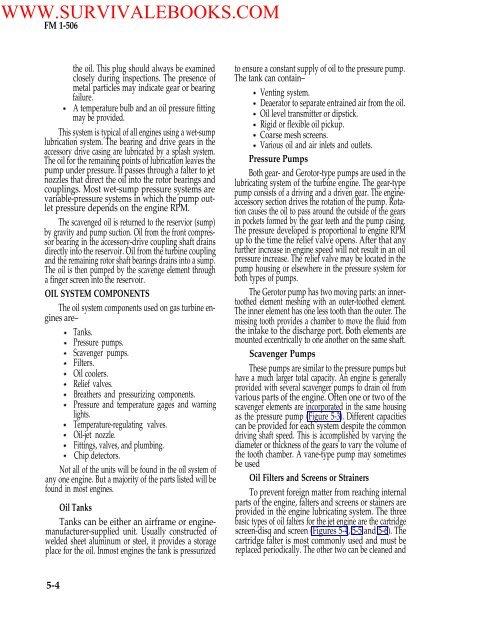FM 1-506 Fundamentals of Aircraft Power Plants ... - Survival Books
FM 1-506 Fundamentals of Aircraft Power Plants ... - Survival Books
FM 1-506 Fundamentals of Aircraft Power Plants ... - Survival Books
Create successful ePaper yourself
Turn your PDF publications into a flip-book with our unique Google optimized e-Paper software.
WWW.SURVIVALEBOOKS.COM<strong>FM</strong> 1-<strong>506</strong>the oil. This plug should always be examinedclosely during inspections. The presence <strong>of</strong>metal particles may indicate gear or bearingfailure.A temperature bulb and an oil pressure fittingmay be provided.This system is typical <strong>of</strong> all engines using a wet-sumplubrication system. The bearing and drive gears in theaccessory drive casing are lubricated by a splash system.The oil for the remaining points <strong>of</strong> lubrication leaves thepump under pressure. It passes through a falter to jetnozzles that direct the oil into the rotor bearings andcouplings. Most wet-sump pressure systems arevariable-pressure systems in which the pump outletpressure depends on the engine RPM.The scavenged oil is returned to the reservior (sump)by gravity and pump suction. Oil from the front compressorbearing in the accessory-drive coupling shaft drainsdirectly into the reservoir. Oil from the turbine couplingand the remaining rotor shaft bearings drains into a sump.The oil is then pumped by the scavenge element througha finger screen into the reservoir.OIL SYSTEM COMPONENTSThe oil system components used on gas turbine enginesare–Tanks.Pressure pumps.Scavenger pumps.Filters.Oil coolers.Relief valves.Breathers and pressurizing components.Pressure and temperature gages and warninglights.Temperature-regulating valves.Oil-jet nozzle.Fittings, valves, and plumbing.Chip detectors.. .Not all <strong>of</strong> the units will be found in the oil system <strong>of</strong>any one engine. But a majority <strong>of</strong> the parts listed will befound in most engines.Oil TanksTanks can be either an airframe or enginemanufacturer-suppliedunit. Usually constructed <strong>of</strong>welded sheet aluminum or steel, it provides a storageplace for the oil. Inmost engines the tank is pressurizedto ensure a constant supply <strong>of</strong> oil to the pressure pump.The tank can contain–Venting system.Deaerator to separate entrained air from the oil.Oil level transmitter or dipstick.Rigid or flexible oil pickup.Coarse mesh screens.Various oil and air inlets and outlets.Pressure PumpsBoth gear- and Gerotor-type pumps are used in thelubricating system <strong>of</strong> the turbine engine. The gear-typepump consists <strong>of</strong> a driving and a driven gear. The engineaccessorysection drives the rotation <strong>of</strong> the pump. Rotationcauses the oil to pass around the outside <strong>of</strong> the gearsin pockets formed by the gear teeth and the pump casing.The pressure developed is proportional to engine RPMup to the time the relief valve opens. After that anyfurther increase in engine speed will not result in an oilpressure increase. The relief valve may be located in thepump housing or elsewhere in the pressure system forboth types <strong>of</strong> pumps.The Gerotor pump has two moving parts: an innertoothedelement meshing with an outer-toothed element.The inner element has one less tooth than the outer. Themissing tooth provides a chamber to move the fluid fromthe intake to the discharge port. Both elements aremounted eccentrically to one another on the same shaft.Scavenger PumpsThese pumps are similar to the pressure pumps buthave a much larger total capacity. An engine is generallyprovided with several scavenger pumps to drain oil fromvarious parts <strong>of</strong> the engine. Often one or two <strong>of</strong> thescavenger elements are incorporated in the same housingas the pressure pump (Figure 5-3). Different capacitiescan be provided for each system despite the commondriving shaft speed. This is accomplished by varying thediameter or thickness <strong>of</strong> the gears to vary the volume <strong>of</strong>the tooth chamber. A vane-type pump may sometimesbe usedOil Filters and Screens or StrainersTo prevent foreign matter from reaching internalparts <strong>of</strong> the engine, falters and screens or stainers areprovided in the engine lubricating system. The threebasic types <strong>of</strong> oil falters for the jet engine are the cartridgescreen-disq and screen (Figures 5-4, 5-5 and 5-6). Thecartridge falter is most commonly used and must bereplaced periodically. The other two can be cleaned and5-4
















